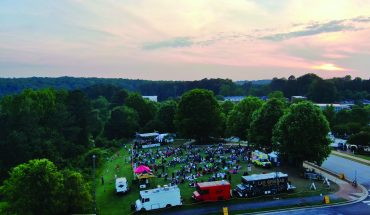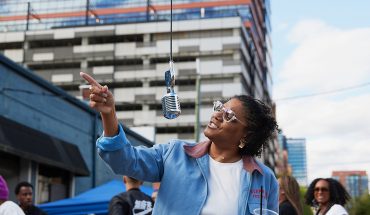Twelve Raleigh architects rethink a community’s downtown
by J. Michael Welton
On a cool, rainy Saturday afternoon in early October, three intrepid women – two architects and a landscape architect – ventured out, on foot, from Town Hall in Wake Forest. They were determined to locate a holy grail in the surrounding landscape – a natural water feature to enhance a new urban plan for the nearly 200-year-old town.
The three were part of a team of 12 Raleigh architects who’d been invited by Wake Forest Downtown, a nonprofit charged with fostering the health and vitality of downtown, to re-imagine it. The architects were working en charrette – a 19th-century French term from the Ecole des Beaux-Arts in Paris. It’s shorthand for an intense, day-long design workshop.
Erin Sterling Lewis, Tina Govan, and Julieta Sherk had already taken one walking tour that morning, during which Lewis had heard about foot paths along a natural stream partially covered by concrete and asphalt. Uncovering it might be an interesting idea, the three designers reasoned. Now, umbrellas in hand, the group slipped down to Miller Park, ran across Roosevelt Street, trudged up a residential footpath on the eastern fringe, then rambled down to the town cemetery. Along the way, they monitored their stream as it surfaced at grade level, disappeared underground, then popped back up again.
Returning to Town Hall, they huddled with three other architects earnestly engaged in sketching out their own design strategies. Michael Stevenson was hatching a plan for two urban “bookends” – a transportation hub at the town’s south end and a cultural hub at its north, with 1,600 linear feet of shops, homes, and offices on South White Street in between. Louis Cherry was drawing up a culinary incubator where multiple chefs could lease kitchen spaces, with a bar dropped strategically into its center. And Frank Harmon quietly sketched out a train station, a bus terminal, and residential units for the transportation hub.
Across the room, Matt Hale was working through drawings for a boutique hotel to stand next to a restaurant he’d already designed and built. Anthony Garcia was dreaming up ways to insert a wall of storefront glass into a brick facade along the town’s Roosevelt Street gateway.
Robby Johnson and Taylor Medlin were sketching out a pedestrian mall to link a pristine Town Hall with the messy vitality of commerce on White Street. Albert McDonald was working through plans for a rooftop bar on a restaurant he proposed for the intersection of White Street at Roosevelt Street. And Brad Burns was reinvigorating a forgotten Art Deco gem – transforming it from wood-paneled barbershop to light-infused cafe with indoor and outdoor seating.
It all took place in a tight window of time between 8:30 a.m. and 5:00 p.m., with presentations to town officials afterwards. The architects’ concepts are now slated for the Wake Forest Renaissance Plan – a toolbox of guidelines for future developers, investors, and property owners.
And if Wake Forest Mayor Vivian Jones has her way, each of these sketches will one day become reality. “As staff and elected officials go forward, and the private sector comes into downtown, they’ll show the ideas and encourage them to follow through with them,” she says. “If they do that with the architects, that would be great – but to follow through on them is what I anticipate.”
That would mean a series of positive eventual outcomes, including that daylit, holy grail of a stream, meandering in a park-like setting through the center of town.
Food for Thought
Anyone considering the idea of opening a new restaurant in an old building would do well to listen to an expert on the process.
That’s the logic that leaders of Wake Forest Downtown – the organization that presented and funded the October architectural charrette – applied when they invited Chef Matt Kelly, developer and owner of Durham’s Vin Rouge and Mateo restaurants, to brief 12 Raleigh architects studying their town.
Kelly spent an hour talking about the restaurant business, then fielded questions about buildings, parking, and funding. As it turns out, Wake Forest may be on the right track. “Right now, small Southern towns are on the upswing,” he says. “Davidson, N.C. has a restaurant that’s in the Bon Appétit top ten. And 10 years ago – a James Beard award in Raleigh? Who would think it?”
Kelly’s experienced. He’s opened up multiple restaurants in a single year – in Charlotte at SouthPark; in Wilmington; and in Durham at The Book Exchange – spending $2.5 million in the process. He likes corner locations for their visibility and parking. And he likes to be prepared before he makes a move – though intuition does play a role. “It’s a feeling – you look at a space and you know what it is,” he says. “With designers, you have to listen but not give up your vision. As an owner you have to fight for where the budget’s going.”
A restaurant’s concept and layout – plus how many diners show up – drive its profitability. Change a floor plan or add a feature, and you might lose money. “The layout is about what I can do with this space – how many seats with this concept in mind?” he says. “The concept is the variable. How much can I make from an individual in that seat? How much per square foot?”
And believe it or not, scarcity of parking spaces can be an asset, not a liability, in developing a restaurant for a small town. The more people on the sidewalks, the better the business for all. “Plan on not having (your own) parking – that’s part of the gig, because you have to walk and pass other businesses,” he says. “The key is to let people know where the parking is – you don’t want it to be a secret.”
Now that the economy’s on the rebound, there’s more willingness to invest in restaurants by property owners and even groups of individuals in the community. “A thousand people giving $500 each – it can work,” he says. “Anything can work.”
But, the veteran chef says, 50 percent of a restaurant’s success still depends on luck.








